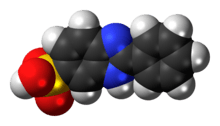Phenylbenzimidazole sulfonic acid
 | |
 | |
| Names | |
|---|---|
| IUPAC name
2-Phenyl-3H-benzimidazole-5-sulfonic acid | |
| Identifiers | |
| 27503-81-7 | |
| 3D model (Jmol) | Interactive image |
| ChemSpider | 31267 |
| ECHA InfoCard | 100.044.078 |
| KEGG | D10005 |
| PubChem | 33919 |
| UNII | 9YQ9DI1W42 |
| |
| |
| Properties | |
| C13H10N2O3S | |
| Molar mass | 274.30 g/mol |
| Hazards | |
| Safety data sheet | Cole Parmer Material Safety Data Sheet |
| Except where otherwise noted, data are given for materials in their standard state (at 25 °C [77 °F], 100 kPa). | |
| | |
| Infobox references | |
Ensulizole (INN[1]) is a common sunscreen agent. In 1999, the United States Food and Drug Administration regulated that the name ensulizole be used on sunscreen labels in the United States. Phenylbenzimidazole sulfonic acid is primarily a UVB protecting agent providing only minimal UVA protection. The scope of UVB is 290 to 340 nanometers whereas the UVA range is 320 to 400 nanometers.[2] For better UVA protection, it must be paired with avobenzone, titanium dioxide, or zinc oxide; outside of the United States it can also be paired with a UV absorber of the Tinosorb or Mexoryl types. Because phenylbenzimidazole sulfonic acid is water-soluble, it has the characteristic of feeling lighter on skin. As such, it is often used in sunscreen lotions or moisturizers whose aesthetic goal is a non-greasy finish.[3] The free acid is poorly soluble in water, so it is only used as its soluble salts.[4]
References
- ↑ "International non-proprietary name". Medinet. Retrieved 6 May 2016.
- ↑ http://www.uspdqi.org/pubs/monographs/sunscreen_agents.pdf
- ↑ eMedicine - Sunscreens and Photoprotection : Article by Stanley B Levy
- ↑ http://www.merck.de/servlet/PB/menu/1254590/index.html